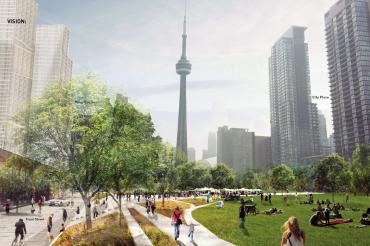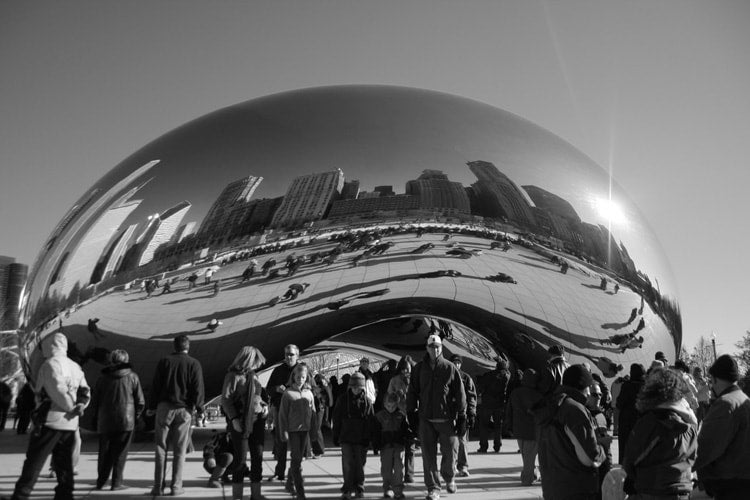Toronto Rail Deck: U of T experts on the pros and cons

Published: August 5, 2016
A proposed 21-acre downtown Toronto park is being touted as a bold project that will help redefine the city. But will it?
The Rail Deck Park would be built over railway tracks – a detail that sparked instant comparisons to Chicago’s Millennium Park, which cost hundreds of millions of dollars
Mayor John Tory estimated the Toronto price tag as “tens of millions of dollars” per acre and said the city is talking with CN and Toronto Terminal Railways to secure the rights to the open space above the tracks for public use.
The city is also hoping to get funds from Ottawa, the province, developers and private donations to help pay for its signature park. City planners are saying the park, which will run from Bathurst Street to the Rogers Centre, will become a central destination for all Torontonians.
U of T News spoke with Gabriel Eidelman, assistant professor at U of T’s School of Public Policy and Governance, and Larry Richards, professor emeritus and former dean of the John H. Daniels Faculty of Architecture, Landscape and Design, about why Toronto needs this park – and whether it’ll ever get built.
Is having a downtown park a good idea? How will it help the city?
GE: I don’t think there’s any question a new downtown park is a good idea, particularly in this area, which has seen, and will continue to see, rapid population growth. Parks have enormous value, not only from a recreational perspective, but also economically (increased property values in the surrounding neighbourhood) and, of course, environmentally (cleaner air, less water runoff, cooler temperatures). The waterfront has several large park spaces, but most are not easily accessible by foot. This proposal would add 21 acres of new parkland — that’s about the size of 21 soccer fields! — within walking distance of thousands of Torontonians. The planning rationale is rock solid.
LR: Yes, having a large downtown park is a good idea. Toronto has become a city of towers with relatively high population density. To balance the density and the fact that people are living in smaller and smaller apartments, public open space is needed, particularly in the downtown core.
It is extremely important to continue developing the lakefront and the Toronto Islands, but this is not enough in terms of parkland. Just as Chicago has its extensive lakefront and generous public parks, and just as Manhattan has its extensive public waterfronts along the Hudson River and East River plus Central Park, Toronto should have multiple types of public parks. Also, this proposed park will enable public open space linkage – Railway Park, Under the Gardiner Park, Waterfront, Toronto Islands, etc…A larger, integrated "green vision" can emerge.
Read more about alumna Judy Matthews and Under the Gardiner
How is a rail deck park constructed?
GE: By creating a “deck” over the tracks with proper soundproofing and drainage to accommodate public access and landscaping. The engineering challenges are complex, but have been successfully overcome in many other cities. Millennium Park in Chicago, home of the famous “Bean” sculpture, is a well-known example.
(Below: photo of Bean sculpture by jotter@ via Flickr)

LR: In terms of constructing the deck, sophisticated engineering is required, and a park on a bridged-deck, spanning over rail tracks, is more expensive than creating a park on the ground. The new over-the-railway park must be designed by the best landscape architects and consulting experts that Toronto can find. Design excellence must be at the forefront of all of these discussions.
Are the cost estimates and projected time to construct realistic?
GE: The announcement did not include specific cost estimates or projected timelines. Both the mayor and the chief planner were noticeably vague in their comments. I suspect city staff have done considerable due diligence to date, but none of this research has so far been made public. We'll have to wait until a staff report is presented to City Council in September for further details.
LR: The preliminary rough estimates I've read about are based on Toronto's recent experience in constructing new parks and on similar projects elsewhere. So they have some credibility. But we know that, realistically, large and complex projects like this typically take twice as long and cost twice as much as first estimated. The City of Toronto does not have a great record in terms of timelines and costs. For example, the restoration and rejuvenation of Nathan Phillips Square took at least twice as long as expected and was over budget. Parts of the NPS project never got completed correctly at all, such as the Bay and Queen Street edges.
Should the city have prioritized other large-scale projects over this park?
LR: Generally speaking, Toronto's public realm is down-at-the-heels and poorly maintained.
Although the new downtown park is a good idea, it would be a shame if its realization negated the urgently needed repairs, upgrades, and maintenance for the public realm (parks, streets and roads, sidewalks, landscape, recreation amenities, etc.). As well, some of the outer, poorer districts are in dire need of better public space and more amenities. Simply stated, the cost and effort for a new grand park should not overwhelm and prevent the upgrading of the "everyday" public spaces throughout the entire city, which are currently second rate by international standards.
Will the park ever get built?
GE: The trite answer is, ask me again once the proposal is actually on paper. The realistic answer is, unlikely. I would love to be proven wrong, but I expect many political, legal, and financial roadblocks. For example, none of the existing landowners (CN and CP railways, as well as Metrolinx) were present at the announcement, which suggests that negotiations will not be easy. And even if political agreement is achieved, project costs will be substantial, in the order of hundreds of millions of dollars, with no obvious source of funding. At this point, the proposal is little more than just another item on the city’s long, $22 billion-list of unfunded capital projects.

